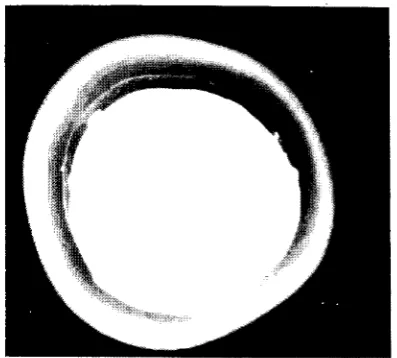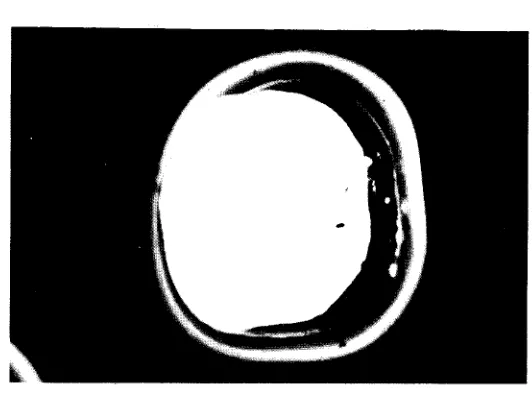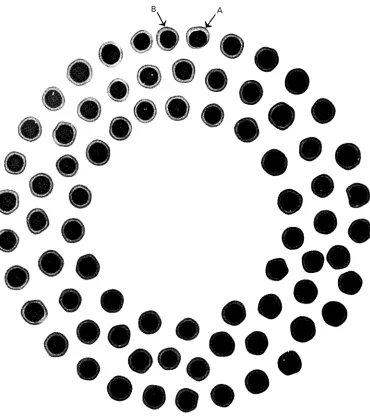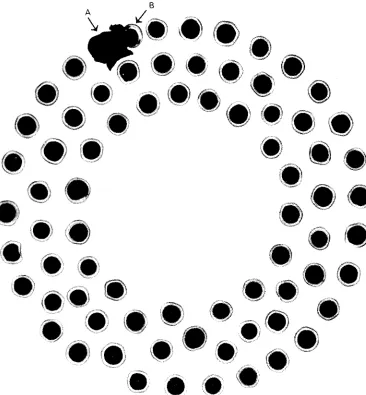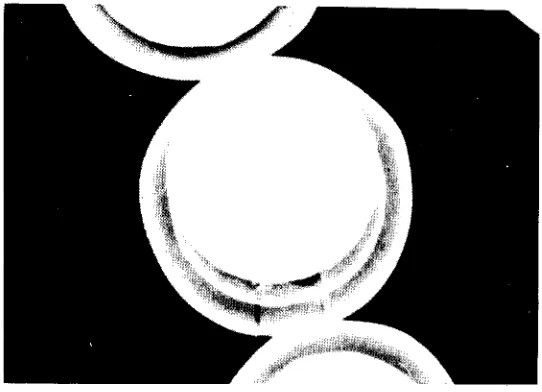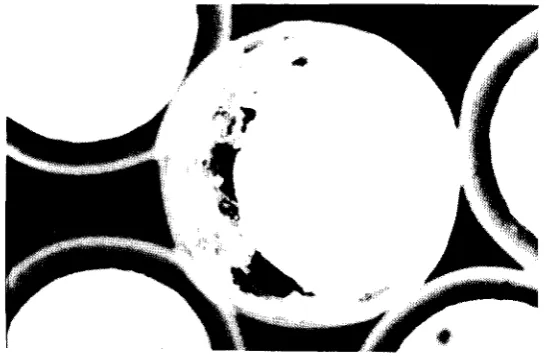COMMISSION OF THE EUROPEAN COMMUNITIES
EXPERIMENTAL OBSERVATIONS
ON uo2 KERNEL/Pye
COATING INTERACTION
by
A.DRAGO
1974
LEGAL NOTICE
This document was prepared under the sponsorship of the Commission of the European Communities.
Neither the Commission of the European Communities, its contractors nor any person acting on their behalf:
make any warranty or representation, express or implied, with respect to the accuracy, completeness, or usefulness of the information contained in this document, or that the use of any information, apparatus, method or process disclosed in this document may not infringe privately owned rights; or
assume any liability with respect to the use of, or for damages resulting from the use of any information, apparatus, method or process disclosed in this document.
This report is on sale at the addresses listed on cover page 4
at the price of B.Fr. 25.
Commission of the European Communities D.G. XIII - C.I.D.
29, rue Aldringen Luxembourg January 1974
COMMISSION OF THE EUROPEAN COMMUNITIES
EUR 5034 e
EXPERIMENTAL OBSERVATIONS ON U02 KERNEL/PyC COATING INTERACTION, by A. DRAGO
Commission of the European Communities
Joint Nuclear Research Centre - Petten Establishment (Netherlands) Luxembourg, January 1974 - 11 Pages - 10 Figures - B.Fr.
25.-The heat treatment induced movement of U02 kernels through the pyro-carbon coatings of unirradiated coated particles was observed by a contact-microradiographic technique. A difference in the development of the phenomenon was observed in particles with visibly damaged coatings.
EUR 5034 e
EXPERIMENTAL OBSERVATIONS ON U02 KERNEL/PyC COATING INTERACTION, by A. DRAGO
Commission of the European Communities
Joint Nuclear Research Centre - Petten Establishment (Netherlands) Luxembourg, January 1974 - 11 Pages - 10 Figures - B.Fr.
25.-The heat treatment induced movement of U02 kernels through the pyro-carbon coatings of unirradiated coated particles was observed by a contact-microradiographic technique. A difference in the development of the phenomenon was observed in particles with visibly damaged coatings.
Joint Nuclear Research Centre Petten Establishent - Netherlands
ABSTRACT
The heat treatment induced movement of U02 kernels through the pyro-carbon coatings of unirradiated coated particles was observed by a contact-microradiographic technique. A difference in the development of the phenomenon was observed in particles with visibly damaged coatings.
KEYWORDS
HEAT TREATMENTS COATED FUEL PARTICLES URANIUM DIOXIDE PYROLYTIC CARBON PELLETS
SILICON CARBIDES MOTION
Introduction.
The kernel/coating interaction was observed by rreans of a nG>n-destructive technique on unirradiated particles having U02 kernels with the coating sequence : buffer-layer-high density pyrocarbon-silicon carbide - high density pyrocarbon. Both monolayer and massive annular compactswere tested, particles at both top and bottom ends of the latter being examinedln the case of the massive
specimens, the radiographs show considerable damage
to
the particle coatings and a destructive exa1nination of the sampleconfirmed this. Fig. I shows the image observed at the microscope of a coated particle after a very light grinding operation which only removed the matrix and outer pyrocarbon layer of the coating. In the picture it is possible to observe the seriously damaged silicon carbide layer.
The non-destructive test utilized to single out the presence of the kernel/ coating interaction and to follow move1nents of the kernel was a contact-1nicroradiographic technique utilizing an X-ray generator capable of working in the low kilovolt range.
Experimental observations.
During the" examination of radiographic images of m.onolayer compacts of coated particles it was observed that in one of these, a few particles shm,ved some kernel/coating interaction.
In
figs. 2 and 3, two of these particles appear as radiographic images. These show the silicon carbide layer and everything enclosed by it. The outer pyrocarbon layer of the particle and the matrix of the monolayer compact are seen as a uniformly black region because the exposure time, and energy, were chosen to reveal the maximum detail in the region inside the silicon carbide shell.In figures 2 and 3 it is posslble to observe the gap existing on one side between the coating and the free surface of the kernels, whereas on the opposite side the region of attack is evident. Behind the free surface of the kernel is a track whose profile exactly reproduces
that of the kernel. This track shows the approximate position occupied by the kernel when the interaction between the kernel and coating
4
-region, of material with an atomic number higher than silicono There are reasons for thinking that the track is caused by the presence of uranium carbide, generated at the start of the process. The maximum distance between the track and the kernel profile is not considered
to exactly represent the deplacement of the kernel but rather to combine kernel movernent with a diffusion process tending to shift the track in the opposite direction.
To observe the dependence of the phenomenon on temperature, the monolayer compact was heat treated in a graphite box which was filled with graphite powder to avoid large temperature gradients.
The temperature chosen for heat treatment was 1800°C, the
temperature to which the compact had been exposed during manufacture0
The heat treatment was carried out in a number of increasing time intervals, the monolayer compact being radiographied to record the movement of the kernels through the coating at each step.
Figures 4 and 5 show the new position of the kernels for the same two particles after 7 hours at I800°C and I hour at I900°C.
The final heat treatment step consisted of two hours at I900°C and then a rapid increase
0£
temperature to 2100 °C followed by immediate rapid cooling. One of the two particles {the one in which the phe-nomenon was the more pronounced) was completely destroyed by the reaction during the final treatment, uranium migration being observed in the m::ttrix surrounding V1e particle. This can be seen on co1nparingfigs. 6 and 7 which show at low magnification, before and after heat treatment,
the monolayer compact containing these two particles, (marked Aa)
B).
Fig. 8 shows the otrer particle (see figs. 3 and 5), which was located in the monolayer compact close to the destroyed particle. The large and shapeless white region is due to uranium migration from the destroyed particle.
The movement of the kernel was also observed in all the other particles present in the monolayer for which the phenomenon had been evident before the start of the several heat treatments. All
Fig •. 9
shows one of the particles present in the full-size compact.
In
this picture it is possible to observe both the kernel attack. and
two large cracks in the coating. It will be noticed that the region between the kernel profile and its track looks like a 11fog11• Such
"fogging" is always present in all the particles showing kernel attack with heavy damage to the coating. Fig. lOshows the reaction between kernel and coating at an advanced stage.
Considerations.
On surveying the radiographs of the monolayer compact it can be observed that the kernel attack appears to have no preferential orien-tation but is randomly orientated among the particles., From this it is concluded that the phenomenon was not generated l)y the presence of a general temperature gradient through the monolayer compact, but perhaps by local temperature gradients. From all the photographic
evidence so 'far accumulated, it appears that whatever the reason for starting, once begun the reaction, continues to proceed preferentially in the same region thus causing the kernel to appear to move in the same direction.
In
cases where the coating is seriously damaged, a "fog1 ' effectis always pre.sent in the region opposite to that through which the kernel is moving. Such a "fogging" in the picture indicates the presence of heavy metal on the internai wall of the coating ; for instance, uranium carbide produced as a consequence of CO release through the damaged coating.
Conclusions.
The present work does not pretend to give an interpretation of the kernel/coating interaction, but aims to show the validity of contact-microradiography as a non-destructive test for studying and
6
-. /
...
Fig. 1 Particle after very light grinding showing damage caused to SiC layer during consolidation of the compact.
[image:8.565.205.497.147.346.2] [image:8.565.98.275.459.672.2] [image:8.565.302.501.494.673.2]Fig. 4 Particle A after 7 hours at 1800°C and 1 hour at l 900°C
[image:9.690.141.407.164.365.2] [image:9.690.143.407.470.651.2]8
-A
••
• •
••
•••
•••
•••••
•••
•••
[image:10.690.232.602.184.601.2]. l A an . . part1c es t containing
compac . 7 Monolayer
Fig. final heat treatment.
•
[image:11.688.86.452.204.599.2]1 0
-Fig. 8 Particle B after the final heat treatment ~artly obscured by
heavy metal diffused from particle A]
Fig. 9 Particle from full-size compact showing kernel attack and
[image:12.688.214.559.77.710.2] [image:12.688.287.558.471.667.2]All scientific and technical reports published by the Commission of the European Communities are announced in the monthly periodical
"euro-abstracts". For subscription (1 year: B.Fr. 1 025,-) or free
specimen copies please write to :
.. :::::::::::::::::::::::::::::::::::
.::fi,~lfii~1111~g11gmmnm1i~imi
Office for Official Publications of the European Communities
Botte postale 1003
Luxembourg 1
(Grand-Duchy of Luxembourg)
/lrnrnrn;rn
:::,,::.!mm
To disseminate knowledge is to disseminate prosperity - I mean!::
irnmrnrnii
general prosperity and not individual riches - and with prosperity ::::::::::::::: disappears the greater part of the evil which is our heritage from ::mm:::::::::::::::::::::: darker times.
SALES OFFICES
The Office for Official Publications sells all documents published by the Commission of the European Communities at the addresses listed below, at the price given on cover. When ordering, specify clearly the exact reference .and the title of the document.
UNITED KINGDOM
H.M. Stationery Office
P.O. Box 569
London S.E. 1-Tel. 01-928 69 77, ext. 365
BELGIUM
Moniteur beige - Belgisch Staatsblad
Rue de Louvain 40-42 - Leuvenseweg 40-42 1 OOO Bruxelles - 1 OOO Brussel - Tel. 12 00 26 CCP 50-80 - Postgiro 50-80
Agency:
Librairie europeenne - Europese Boekhandel Rue de la Loi 244 - Wetstraat 244 1040 B ruxelles - 1040 Brussel
DENMARK
J.H. Schultz - Boghandel
M(llntergade 19
DK 1116 K(llbenhavn K ~ Tel. 1411 95
FRANCE
Service de vente en France des publications des Communautes europt!enqes - Jqurnal officiel
26, rue Desaix - 75 732 Paris - Cedex 15• Tel. (1) 306 51 00 - CCP Paris 23-96
GERMANY (FR)
Verlag Bundesanzeiger
5 Koln 1 - Postfach 108 006 Tel. (0221) 21 03 48
Telex: Anzeiger Bonn 08 882 595 Postscheckkonto 834 00 Koln
GRAND DUCHY OF LUXEMBOURG
Office for Official Publications of the European Communities
Boite postale 1 003 - Luxembourg Tel. 4 79 41 - CCP 191-90
6171
Compte courant bancaire: BIL 8-109/6003/200
IRELAND
Stationery Office - The Controller
Beggar's Bush Dublin 4 - Tel. 6 54 01
ITALY
Libreria de/lo Stato
Piazza G. Verdi 10
00198 Roma - Tel. (6) 85 08 CCP 1/2640
NETHERLANDS
Staatsdrukkerij- en uitgeverijbedrijf
Christoffel Plantijnstraat
's-Gravenhage - Tel. (070) 81 45 11 Postgiro 42 53 00
UNITED STATES OF AMERICA
European Community Information Service 2100 M Street, N.W.
Suite 707
Washington, D.C., 20 037 - Tel. 296 51 31
SWITZERLAND
Librairie Payot
6, rue Grenus
1211 Geneve-Tel.318950 CCP 12-236 Geneva
SWEDEN
Librairie C.E. Fritze
2, Fredsgatan Stockholm 16
Post Giro 193, Bank Giro 73/4015
SPAIN
L,breria Mundi-Prensa
Castello 37
Madrid 1 - Tel. 275 51 31
OTHER COUNTRIES
Office for Official Publications of the European Communities
Boite postale 1003 - Luxembourg 6171 Tel.4 7941 -CCP 191-90
Compte courant bancaire: BI L 8-109/6003/200
